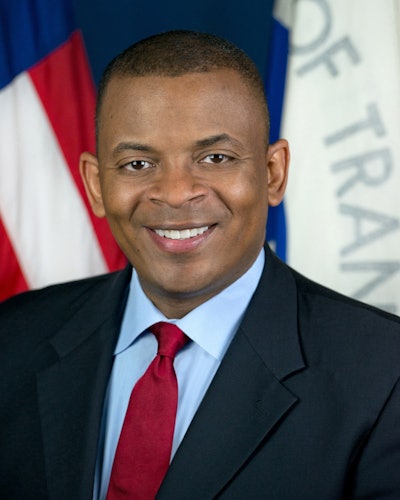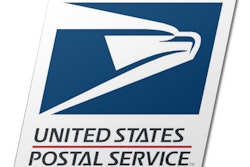
U.S. Transportation Secretary Anthony Foxx released the draft National Freight Strategic Plan, which offers specific policy proposals and solutions to address the growing challenges of moving freight in this country. Now open for public comment, the draft plan is a step to support the nation’s economy through the efficient movement of goods, while recognizing and responding to future infrastructure challenges. He was joined by Sen. Maria Cantwell at Seattle Public School headquarters.
According to the most recent data released from the Bureau of Transportation Statistics, freight shipments last month reached an all-time high and were 30.4 percent higher than the recent low in April 2009 during the recession. While this increase in freight traffic is good news for the economy, concerns remain that infrastructure cannot accommodate continued growth: In the next 30 years the population of the U.S. is expected to grow by 70 million people, and freight traffic is expected to increase by 42 percent by 2040.
“With an increasingly competitive and complex global marketplace and a deteriorating transportation infrastructure that is unfortunately showing the effects of age and underinvestment, the need for us to have a national freight plan could not be more urgent,” said U.S. Secretary of Transportation Anthony Foxx.
This draft plan takes a comprehensive look at the nation’s freight needs and future challenges and offers a roadmap for improvements. It proposes solutions and strategies to address the infrastructure, institutional, and financial bottlenecks that hinder the safe and efficient movement of goods. It also identifies successful programs already in place to improve freight planning and investment, and proposes new programs and ideas that could make more progress possible. It also recognizes the benefits of establishing a strong freight program in the next reauthorization bill.
"Congestion on rails, surface streets, and at our ports across the Pacific Northwest costs businesses billions of dollars a year and gives an edge to competitors around the globe. The National Freight Strategic Plan means places like Seattle and Tacoma will be part of our national strategy to quickly move products through traffic congested areas," said Cantwell.
These strategies include efforts to reduce congestion and increase efficiency while improving safety and reliability, and reducing adverse impacts on the environment and communities. This will include incorporating new technologies allowing for better quality data collection and faster analysis of freight routes, travel times, and infrastructure capacity.
Specific strategies include:
- Ensure dedicated freight funding: The draft plan emphasizes the importance of a dedicated freight program that would improve the movement of freight and meet regional economic demand and would require or incentivize state freight advisory committees, state freight plans, and cross-jurisdictional/cooperative planning.
The GROW AMERICA Act would provide $18 billion over six years through two dedicated, multimodal freight grant programs for targeted investments.
- Identify major trade gateways and multimodal national freight networks/corridors: U.S. DOT is releasing a draft Multimodal Freight Network (MFN) map to inform planners, private sector stakeholders, and the public about where major freight flows occur and where special attention to freight issues may be most warranted. U.S. DOT and the U.S. Department of Commerce have monitored and analyzed major trade gateways and freight corridors for decades, but the draft MFN combines the most critical modal components and shows the connections between them.
- Facilitate multijurisdictional, multimodal collaboration and solutions: U.S. DOT will continue its work to support local, state, and interagency collaboration, including close cooperation with port authorities, private sector stakeholders, and agencies in Canada and Mexico; sharing best practices for freight planning; supporting advisory committees and public forums with stakeholders; and encouraging effective use of funding available at the national level.
- Ensure availability of better data and models: U.S. DOT will continue to develop and deploy newer and more advanced freight data resources to the planning community and advance the measurement and analysis of transit times for different commodities from a multimodal, origin-to-destination perspective. Congress could enhance U.S. DOT’s authority to collect intermodal freight data by giving U.S. DOT’s Bureau of Transportation Statistics the authority to assemble intermodal freight movement data under the Intermodal Transportation Data Program, as proposed in the GROW AMERICA Act.
- Improve safety and support the adoption of new transportation technologies: U.S. DOT is undertaking new and innovative efforts to improve freight transportation safety. The Department recently announced the formation of a National Coalition on Truck Parking to improve commercial driver safety. U.S. DOT will also efforts to adopt new and exciting transportation technologies, including autonomous vehicles that promise to allow for safer and more reliable freight transportation.
- Develop the next generation freight transportation workforce: U.S. DOT is committed to promoting economic opportunity through high-quality transportation jobs as part of the President’s Ladders of Opportunity Initiative. Efforts include developing freight skills for State transportation agency and MPO staff through a growing body of resources and guidance on freight planning, and pushing for greater authority to develop workforce plans.
The most recent surface transportation reauthorization law, the Moving Ahead for Progress in the 21st Century Act (MAP-21), directed the U.S. Department of Transportation to develop a National Freight Strategic Plan laying out a course of action to meet National Freight Policy goals designed to improve the movement of freight in the U.S. The Department welcomes the public to provide feedback and comment on the draft National Freight Strategic Plan. To submit your thoughts and to learn more about the draft plan, visit www.transportation.gov/freight.













